DAILY PRACTICES.
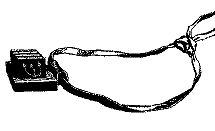
|
with fix knotted loop, Amsterdam, 1733. |
 Tefillin are small square black leather boxes, containing quotations from the Bible, which are placed on the forehead and the arm during the weekday morning prayers. They are intended to fulfil literally the words of Deuteronomy:
Tefillin are small square black leather boxes, containing quotations from the Bible, which are placed on the forehead and the arm during the weekday morning prayers. They are intended to fulfil literally the words of Deuteronomy:
These words that I command you this day ... you shall bind them for a sign upon your hands and they shall be for frontlets between your eyes.1.
The name Tefillin means prayers, and the boxes contain four passages from the Torah. These passages are Exodus 13, 1-10, Exodus 13, 11-16, Deuteronomy 6, 4-9 and Deuteronomy 11, 13-21. These passages were selected because they each contain a reference both to a sign upon your hands and to frontlets between your eyes. The practice of Tefillin was clearly intended to fulfil literally what these passages appeared to require. (But see also ALLEGORICAL INTERPRETATION) Two of the four passages are taken from the  Sh'ma, the prayer which is said at the morning and evening services.
Sh'ma, the prayer which is said at the morning and evening services.
Tefillin are not worn on the Sabbath or on festivals. This is because Tefillin are a sign upon the hands and the Sabbath itself is described as a sign2.
(1.) Deut. 6, 6-8. (2.) Exodus 31, 13.
DATE OF TEFILLIN.
Rabbi Judah ben Bathyra claimed that he had Tefillin dating back to the time of Ezekiel.3. This is probably an exaggeration, but the custom is clearly very old. Some of the earliest examples of Hebrew writing to survive are fragments from Tefillin. Tefillin were found in the Qumran caves dating from about the 1st cent. BCE. And the Nash Papyrus of the 2nd. cent. CE is another example. Josephus refers to them 4. as does the New Testament.5. The New Testament refers to them using the Greek word Phylacteries. This is not an accurate translation. Because a phylactery is an amulet, which usually means a protection from evil, while Tefillin are used for ritual connected with prayer and are not thought of as protective.
(3.) San. 92b. (4.) Antiquities 4, 8, 13. (5.) Matthiew 23, 5.
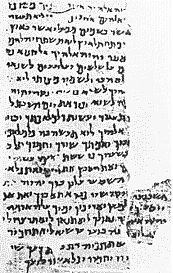 |
10 Commandments and Sh'ma. (not shown), 2nd Cent BCE. |
HISTORY OF TEFILLIN.
Originally, there were different practices as to which texts were included in Tefillin. The most important source passage was Deut. 6, 4-9. There it says These words which I command you this day...You shall bind them for a sign upon your hands, etc. The question was what does these words refer to? Many thought they referred to Deut 6, 4-5 which said Hear O Israel, the Lord our God, the Lord is one. And you shall love the Lord your God with all your heart and all your soul and with all your might. For this has always been the key belief of Judaism. However many others pointed out that Deut. Chapter 5 which precedes the passage contains the Ten Commandments, and that These words refers to them. A number of the early Tefillin found therefore contain the Ten Commandments. There is evidence that originally the Ten Commandments used to be recited with the three paragraphs of the Sh'ma in the Temple.6. During the Talmudic period the practice ceased lest sectarians might say that only these Ten commandments had Divine authority and not the remaining 603 of them.7.
The Talmudic Rabbis recognised stages of development in the use of Tefillin. They stated that although the use of Tefillin was a biblical commandment, the precise details of exactly how to carry it out were the work of the later scribes.8. There is also evidence that Tefillin were worn all day.9.
(6.) Tam. 5, 1. (7.) Ber. 12a. (8.) San. 88b. (9.) Men. 36a.
DESCRIPTION.
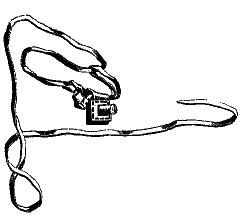 |
with slip knot. Amsterdam, 1733. |
The black leather boxes are usually cubic, with a larger square base. The 1733 illustration of the box for the arm is cylindrical but this would be unusual today. Inside the boxes are the four quotations hand-written by a scribe on leather as a Torah scroll is written. The box for the arm has the four quotations written one after the other on a long strip. While the box for the head has four divisions inside each, one of the quotations is folded up and secured. There was a difference of opinion between Rashi and his grandson Rabbenu Tam as to the order of the four quotations. This seems to reflect different traditions as examples of both kinds were found at Qumran.
On the outside of the box for the head, the Hebrew letter shin is written on each side. 10. However on one side the letter is given an extra arm. The four arms of the letter presumably represent the four quotations. While the shin is mentioned in the talmudic discussions, the shin with four arms is first spoken of by later (c. 13th Cent.) commentaries.11.
(10.) Men. 35a. (11.) Tosafot to Men. 35a.
EXPLANATIONS.
The  Shin is thought to stand for Shaddai, one of the names of God. The knot is thought as being in the shape of the
Shin is thought to stand for Shaddai, one of the names of God. The knot is thought as being in the shape of the  Daled. While see the
Daled. While see the  yod in the seven winds round the arm added to the three round the finger. (Yod has the numerical value of ten.) A shin can also be seen on the hand formed by the way that the straps are shaped when the binding is completed. Some regard the ten turns to represent the Ten Commandments. And some Kabbalists regard the twists round the finger as symbolising be wedded to God and his commandments, reciting Hosea 2, 21-22 which speaks of betrothal. The problem about this interpretation is that the traditional finger for putting the wedding ring on is the first and not the second finger. The animation shows the straps being wound clockwise on the arm, there are some who bind them on anticlockwise.
yod in the seven winds round the arm added to the three round the finger. (Yod has the numerical value of ten.) A shin can also be seen on the hand formed by the way that the straps are shaped when the binding is completed. Some regard the ten turns to represent the Ten Commandments. And some Kabbalists regard the twists round the finger as symbolising be wedded to God and his commandments, reciting Hosea 2, 21-22 which speaks of betrothal. The problem about this interpretation is that the traditional finger for putting the wedding ring on is the first and not the second finger. The animation shows the straps being wound clockwise on the arm, there are some who bind them on anticlockwise.
 | DEMO: PUTTING ON TEFILLIN |
ALLEGORICAL INTERPRETATION.
Despite the long tradition of donning Tefillin, it is quite likely that the four proof texts contained in them were not intended to be taken literally. Exodus 13,9 says And it shall be for you as a sign upon your hand and as a reminder between your eyes in order that the Torah shall be in your mouth. It is clear that this did not mean that the written text of the Torah was to be put in the mouth. And if this was so, then equally the written text was not required to be put on our arms and foreheads. Rabbi Simeon ben Meir (Rashbam), the grandson of Rashi and brother of Rabbenu Tam, took this view. He said that the plain meaning is that it should be as a perpetual reminder as if it were written upon your hand.12.
This understood the passages to teach that putting these words between our eyes meant that we should think about the commandments. And that binding them on our hands meant that our deeds should be carrying out the commandments. Such an interpretation gives the verses a far more important meaning. Instead of being just a command to carry out rituals with little leather boxes when we say our morning prayers, they were now seen as commanding us to carry out God's teachings in every thing we do in life. As a result the literal interpretation has tended to trivialise some deeply religious verses.(12.) Rashbam on Ex 13, 9.
MEZUZOT.
 (Mezuzah, the singular of Mezuzot) is the name for the little box fixed onto the door post of a Jewish home. The word literally means door post. The custom is very ancient and is derived from Deuteronomy 6, 4 - 9, In the section spoken of as the
(Mezuzah, the singular of Mezuzot) is the name for the little box fixed onto the door post of a Jewish home. The word literally means door post. The custom is very ancient and is derived from Deuteronomy 6, 4 - 9, In the section spoken of as the  (Sh'ma) we are told These words which I command you this day... You shall write them on the door posts of your house and upon your gates. The fixing of a Mezuzah is therefore regarded as a mitsvah (commandment.) For other reasons for this practice see MEZUZAH EXPLANATIONS.
(Sh'ma) we are told These words which I command you this day... You shall write them on the door posts of your house and upon your gates. The fixing of a Mezuzah is therefore regarded as a mitsvah (commandment.) For other reasons for this practice see MEZUZAH EXPLANATIONS.
DESCRIPTION OF MEZUZOT.
Inside of a Mezuzah is a small scroll. There are two occasions when this command occurs in the Torah the first is quoted in the section above and the second is in Deut. 11, 13 - 21. Consequently the scroll inside the mezuzah contains these two passages. The text is hand-written on leather parchment by a scribe in the same way that a Torah scroll is written. The scroll also has two other things written on the back of it. The first is the word Shaddai, which is one of the names of God. The scroll is usually rolled in such a way that the name is visible through a hole in the outer casing of the Mezuzah. However many modern Mezuzot are made without such holes and instead have the word written on the outside of the case or else just have the Hebrew letter  shin.
shin.
The second thing that is written on the back are the Hebrew letters  which are pronounced Cozu b'muchsaz cozu. This appears to mean nothing; but it is written in a simple code. Each letter of the phrase has been replaced by the letter following it in the Hebrew alphabet. When deciphered it means The Lord our God is the Lord. It is therefore a quotation containing three words taken form the first line of the Sh'ma and states a belief in the unity of God.
which are pronounced Cozu b'muchsaz cozu. This appears to mean nothing; but it is written in a simple code. Each letter of the phrase has been replaced by the letter following it in the Hebrew alphabet. When deciphered it means The Lord our God is the Lord. It is therefore a quotation containing three words taken form the first line of the Sh'ma and states a belief in the unity of God.
HISTORY OF MEZUZOT.
One of the earliest references to Mezuzot was by Josephus in the 1st cent CE 13. A fragment of a Mezuzah was found in the Dead Sea Scroll caves at Qumran dating probably from about the 1st cent BCE 14. The Tannaim and the Amoraim (Rabbis of 1st to 5th centuries CE) formulated rules for the writing and use of the Mezuzah. By the time of the 11th century CE Jews had started adding extra wording to Mezuzah scrolls. They added the names angels, as if asking them to protect their homes from harm. This custom was strongly criticised by Maimonides who wrote:
There is no harm in writing Shaddai on the outside; but those who write on the inside the names of angels, or holy names, or verses or other formulae, will be among those who have no share in the world to come. (will have no reward) For these foolish people not only prevent the fulfilment of a great commandment, which has for its object, the remembrance of God's unity, and the love for Him and the worship of Him, but they turn the Mezuzah into an amulet used for their own selfish interest, believing in their foolish hearts that it will protect their material possessions.15.Maimonides' view prevailed and now Mezuzot do not contain such additions.
(13.) Antiquities, 4, 8, #13. (14.) EJ vol 11, p. 1476. (15.) Mishne Torah, Tefillin, 5, 4.
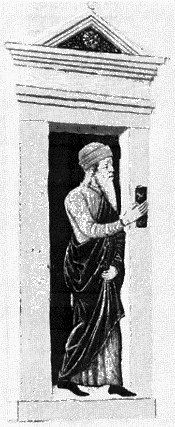 |
Touching a vertical Mezuzah. |
MEZUZAH PRACTICES.
The Mezuzah is fixed to the right hand door post as you enter the house or room. It is fixed in a diagonal position, with the top towards the entrance, and it should be somewhere in the top third of the door post. It should be fixed to those rooms which are lived in, but not to bathrooms, store rooms etc. A synagogue only needs a Mezuzah if someone actually lives in part of the synagogue premises.16. When fixing a Mezuzah there is a blessing to be said which expresses the awareness that we are fulfilling a mitsvah (commandment.)
(16.) S.A. Yoreh De'ah, 286, 3.
MEZUZAH EXPLANATIONS.
Mezuzot are used because:
- They are commanded in the Torah.17.
- They give witness to a belief in God.18.
- They remind us that we should live as God wants us to, whether inside or outside the home.19.
- They help to identify the home as Jewish.
- Some Jews still believe the Mezuzah is there to protect the home. They point to the three Hebrew letters of Shaddai and say that they stand for
 shomer daltot Yisrael, He who watches over the doors of Israel. But this is the kind of superstition that Maimonides condemned.
shomer daltot Yisrael, He who watches over the doors of Israel. But this is the kind of superstition that Maimonides condemned.
Many Jews when they go in or out, kiss their hand and touch the Mezuzah to show that they have remembered God and His commandments. Some of these say: May God keep my going out and coming in both now and evermore.20.
FIXING SLANT-WISE. This is done because:
- As one goes into the house one should increase in holiness.
- Mediaeval Rabbis argued whether the Mezuzah should be fixed vertically or horizontally, and the present diagonal position was probably a compromise.21.
- So that the rain may run off easier.
(17.) Deut. 6, 4 - 9, and 11, 13 - 21. (18.) Josephus Ant. 4, 8, #13. (19.) Maimonides Yore De'a 286, 3. (20.) Kitsur Shulchan Aruch; 1, 11, #24. (21.) For a Divine precedent for such a compromise see Baba Metzia 59b.
VALUE OF MEZUZOT.
It is impossible to say of the Mezuzah that it is a good or bad practice, until one knows the reason the individual has for fixing it. If it is to remind them of God and His commandments and if it inspires them to lead better lives, then it is clearly valid and important practice. But if it was done in the hope of protecting the house from harm, then it is just an example of superstitious behaviour. This illustrates the fact, that it is not what we do so much as why we carry out practices, which is really the most important thing.
MEZUZOT - INTERESTING FACTS.
- There is evidence that the very early days the practice was to include the Ten Commandments in Mezuzot. The reason was that in the Sh'ma (Deut. Ch. 6) the reference to these words which I command you this day were not taken to refer to the unity of God but to the Ten Commandments listed in the preceding chapter (ch. 5.) (see also History of Tefillin.)
- When the Sh'ma states that you shall write these words on your gates, it may not have been intended to be taken literally. The gates of cities included an open place where the elders sat to conduct legal cases. 22. Therefore the meaning may well have been that the Ten Commandments shall applied in the law courts, particularly the one concerning false witness.
(22.) Ruth 4, 11; Deut. 22, 15 and Amos 5, 15 etc.
DAILY PRAYER.
Prayer is the human effort to open oneself to God's influence and to commune with the infinite spirit of the universe. Jewish prayer is not confined to Sabbaths and festivals. It is a daily communion with God. Nor is prayer confined to the Synagogue. There are many prayers, which were intended to be said by the individual in the home.
DAILY SERVICES.
The Bible records that it was the custom to pray three times a day: Daniel went into his house; his windows were open in his chamber toward Jerusalem, and he kneeled upon his knees three times a day, and prayed, and gave thanks before his God.23. This account of private prayer is interesting because we have not knelt for prayer for many centuries. Daniel's three sessions of private prayer corresponded to the three services of public prayer:
- EVENING PRAYER.
 (MA'ARIV)
(MA'ARIV)
- MORNING PRAYER.
 (SHACHARIT)
(SHACHARIT)
- AFTERNOON PRAYER.
 (MINCHAH)
(MINCHAH) - MORNING PRAYER.
The origins of these services are so ancient that nobody knows when the practice started, and the Talmudic Rabbis24. were able to attribute them to the three patriarchs:
R. Jose b. Hanina taught : Abraham instituted the morning Tefillah, as it says, "And Abraham got up early in the morning to the place where he had stood,"25. and 'standing' means only prayer, as it says, "Then stood up Phineas and prayed."26. Isaac instituted the afternoon Tefillah, as it says, "And Isaac went out to meditate in the field at eventide,"27. and 'meditation' means only prayer, as it says, A prayer of the afflicted when he fainteth and poureth out his meditation before the Lord.28. Jacob instituted the evening prayer, as it says, "And he lighted [va-yifga'] upon the place,"29. and 'pegi'ah' means only prayer, as it says, "Therefore pray not thou for this people neither lift up prayer nor cry for them, neither make intercession to [tifga'] Me."30.This account is purely legendary. Although the name of the Minchah service is mentioned in the Bible in connection with Elijah,31. yet the Ma'ariv service was still only optional right into the Talmudic period.32. Rabbi Joshua ben Levi gave another explanation for the three services when he said that they were instituted to replace the daily sacrifices.33.
(23.) Daniel, 6, 11. (24.) Ber. 26b.(25.) Gen. 19, 27. (26.) Psalm 106, 30.(27.) Gen 24, 63. (28.)Psalm 102, 1. (29.) Gen. 18, 11. (30.) Jer. 7, 16. (31.) 1 Kings 18, 36. (32.) Ber. 27b. (33.) Ber. 26b.
MINYAN.
 |
South Spain, 14th cent.CE |
Minyan is the number of people required to be present for public worship. Without this number one is not allowed to say the  K'dushah (Holy, Holy, Holy) in the
K'dushah (Holy, Holy, Holy) in the  Amidah, the
Amidah, the  Bar'chu (the call to prayer) or the Kaddish.34. nor the public reading of the Torah. Orthodox Jews define this number as ten adult Jewish males over the age of 13. This figure was arrived at by Rabbinic logic. The term for a congregation is an 'edah. They looked for the place in the Bible where the smallest number of people were described by this word. They saw that in Numbers 14, 27 the word was used to describe the group of ten spies who gave a discouraging report about the promised land.
Bar'chu (the call to prayer) or the Kaddish.34. nor the public reading of the Torah. Orthodox Jews define this number as ten adult Jewish males over the age of 13. This figure was arrived at by Rabbinic logic. The term for a congregation is an 'edah. They looked for the place in the Bible where the smallest number of people were described by this word. They saw that in Numbers 14, 27 the word was used to describe the group of ten spies who gave a discouraging report about the promised land.
In some small communities where it is sometimes difficult to gather ten men, the rule is sometimes relaxed a little to allow nine men and a boy under thirteen, providing he is holding a  Chumash (Pentateuch).35. Reform and Liberal Jews give full equality to women and therefore count them as part of a minyan. It seems strange that for tradtionalists women are not counted and yet if there are just ten men present and one falls asleep this does not invalidate the minyan.36.
Chumash (Pentateuch).35. Reform and Liberal Jews give full equality to women and therefore count them as part of a minyan. It seems strange that for tradtionalists women are not counted and yet if there are just ten men present and one falls asleep this does not invalidate the minyan.36.
(34.) SA Orach Chayim 55, 1. (35.) SA Orach Chayim 55, 4. (36.) SA Orach Chayim 55, 6.
| ? | IF TEN ADULT MALES ARE REQUIRED FOR A MINYAN, WHAT JEWISH PRACTICE REQUIRES FIVE GRANNIES? |
 | |
DAILY BLESSINGS.
It is often said of Judaism that it is less a faith than it is a way of life. For Judaism enters into all aspects of our life. This is seen best in the numerous blessings which are said on different occasions. Among the blessings listed in the Siddur (the daily and Sabbath prayer book) will be found those on waking in the morning, for putting on a new garment, for seeing a rainbow, washing ones hands, eating various foods, etc as well as those said when we fulfil a commandment. Talmudic Rabbis said that it was forbidden to enjoy such things without saying a blessing.37. Many of the blessings used today date back to the 3rd and 4th centuries CE and can be found in the Talmud in tractate Berachot.38.
In Judaism we do not bless inanimate objects to declare that they are holy. Blessings are said over or concerning things, and they are expressions of thanks to God who created them. So many of prayers in our services are in the form of blessings, which praise or thank God. Therefore, when we say Kiddush on a Sabbath or festival we do not bless the wine and think of it as holy. Instead we thank God the Creator of the fruit of the vine. And the blessing over the day begins Blessed are you Lord, our God, King of the universe, who has sanctified us with His commandments and... (MASCULINITY OF GOD?) This is used on all occasions when we are saying a blessing before carrying out a mitsvah or commandment and usually continues ... and has commanded us to ... and then follows the name of the commandment.
(37.) Ber. 35a. (38.) 18b, 59a ff, etc.
COUNTING OUR BLESSINGS.
The common advice to count our blessings is followed literally by some of the most orthodox of Jews. Ari (Rabbi Isaac Luria, 16th cent.) said that each day a pious Jew should respond Amen to at least 90 blessings, say the  Kedushah (Holy, holy, holy 39.), recite the Kaddish at least ten times and say at least 100 blessings.40. This is derived from that such a person is often referred to as a
Kedushah (Holy, holy, holy 39.), recite the Kaddish at least ten times and say at least 100 blessings.40. This is derived from that such a person is often referred to as a  Tsadiq. The numeric values of the Hebrew letters of this word are 90, 4, 10 and 100. This ingenious explanation is rather spoiled by the commentary also pointing out that one can artificially increase one's tally of Amens by saying 15 of these blessings aloud to one another.41.
Tsadiq. The numeric values of the Hebrew letters of this word are 90, 4, 10 and 100. This ingenious explanation is rather spoiled by the commentary also pointing out that one can artificially increase one's tally of Amens by saying 15 of these blessings aloud to one another.41.
This rather quaint system of counting should not be allowed to put us off from recognising our blessings. In this age when most news media emphasise the evils and wrongs in the world around us, it is even more necessary than ever to remember our blessings.
(39.) Isaiah 6, 3. (40.) Quoted in commentary in Art Scroll Siddur p. 18. (41.) Ibid.
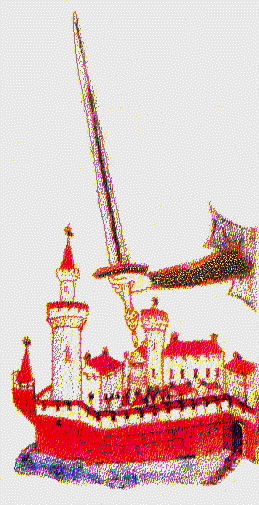 |
"outstretched arm of God" 15th cent, haggadah, Italy (?) |
MASCULINITY OF GOD?
In many places and particularly in the blessings, God is referred to as masculine. So the phrase  melech ha-olam, (King of the universe) and
melech ha-olam, (King of the universe) and  b'mitsvotav (with His commandments) appear to imply a maleness to God. However by the basic definition of Jewish beliefs God has no shape or form.42. God is a spiritual force or power, and such a force or power can have no gender. The problem is purely one of language and the difficulty of trying to speak of a Divine Being in human terms. Hebrew has only two genders - masculine or feminine, and in normal usage the masculine includes the feminine but the reverse is not true. In English, if we did not use the pronouns He or She, the only other one we could use without gender would be it and that would not convey any idea of the greatness of God.
b'mitsvotav (with His commandments) appear to imply a maleness to God. However by the basic definition of Jewish beliefs God has no shape or form.42. God is a spiritual force or power, and such a force or power can have no gender. The problem is purely one of language and the difficulty of trying to speak of a Divine Being in human terms. Hebrew has only two genders - masculine or feminine, and in normal usage the masculine includes the feminine but the reverse is not true. In English, if we did not use the pronouns He or She, the only other one we could use without gender would be it and that would not convey any idea of the greatness of God.
(42.) Maimonides: 13 Principles of Faith. 12th cent.
WHY SAY AMEN?
The word  (amen) is derived from the Hebrew root meaning 'confirm', support' or 'establish'. The word gradually became the standard response to a blessing. The custom is very ancient and was already a standard practice in the 7th century BCE as it is found frequently in Deuteronomy in ritual concerning curses.43. It also occurs in Psalms which were used for worship.44.
(amen) is derived from the Hebrew root meaning 'confirm', support' or 'establish'. The word gradually became the standard response to a blessing. The custom is very ancient and was already a standard practice in the 7th century BCE as it is found frequently in Deuteronomy in ritual concerning curses.43. It also occurs in Psalms which were used for worship.44.
In this early period, most of the prayers were said by the Cohanim (priests) or the Levites and the congregation only expressed agreement. Later it became the standard response to blessings which began Blessed are You, Lord our God� However in the case of the Sh'ma a fuller response survives:  Blessed be His glorious name for ever and ever.45.
Blessed be His glorious name for ever and ever.45.
The custom of saying Amen has remained in Judaism over the centuries but in most cases we do not say Amen to our own prayers, but only to those of someone else. In the Talmud Rabbi Jose said that a person who responds Amen has even greater merit than he who says the blessing.46. Ben Azzai said that if one said it rightly ones days would be prolonged47. Rabbi Josha ben Levi said ones sins would be forgiven and Resh Lakish said the gates of paradise would be opened for him.48. Some Talmudic Rabbis were inclined to exaggerate a little, but the sayings show how important the saying of Amen was to them. Rabbi Hanan ben Abba linked the saying of Amen with the verse Magnify the Lord with me and let us praise His holy name together49.
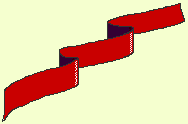
The use of Amen in the early centuries CE is attested by the account of the synagogue in Alexandria which was so large that they had to wave a scarf or turban so that the people at the back of the congregation knew when to say Amen50. The custom of prompting the congregation to say amen can still be found in our liturgy when it says  (v'imru amen) And let us say Amen.
(v'imru amen) And let us say Amen.
The Jewish custom of saying Amen was adopted by Christianity and also to a certain extent by Islam.
(43.) Deut. 27, 15-26. (44.) Psalms 41, 14; 72, 19; 89, 53; and 106, 48. (45.) Louis Ginzberg, JE vol 1, p. 491. (46.) Ber. 53b. (47.) Ber. 47a. (48.) Shab 119b. (49.) Ber. 45a. quoting Psalm 34, 4.(50.) Suk. 51b.
| FOR FULL ALPHABETICAL INDEX |